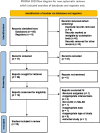The application of antibiotic-loaded bone cement in preventing periprosthetic joint infection: an umbrella review
- PMID: 40249535
- PMCID: PMC12008095
- DOI: 10.1186/s10195-025-00839-w
The application of antibiotic-loaded bone cement in preventing periprosthetic joint infection: an umbrella review
Abstract
Objectives: The purpose of this study was to provide thorough, understandable and precise evidence for the clinical use of antibiotic-loaded bone cement (ALBC) in preventing periprosthetic joint infection (PJI).
Methods: We evaluated the effectiveness of ALBC in preventing PJI by conducting an umbrella review of existing meta-analysis. Four databases, PubMed/MEDLINE, Cochrane Library, Embase and Web of Science, were searched until May 2024. Two reviewers were reviewers for literature screening, and data were extracted independently. AMSTAR 2 guideline and GRADE were also used for quality evaluation. The clinical outcomes were evaluated for effectiveness by several indicators, including surface infection rate (SIR), deep infection rate (DIR), total infection rate (TIR), unadjusted/adjusted all-cause revision rate, and revision rate for PJI.
Results: We synthesized the results of ten meta-analyses. Two meta-analyses had high AMSTAR 2 scores, two had moderate AMSTAR 2 ratings, three had critically low AMSTAR 2 scores, and the remaining meta-analyses had low AMSTAR 2 ratings. In terms of postoperative surgical site infection and revision rate, SIR (OR 1.50, 95% CI 1.14, 1.99, P = 0.004, I2 = 0%), unadjusted all-cause revision rate (RR 1.44, 95% CI 1.08, 1.90, P = 0.011, I2 = 91.8%) and adjusted all-cause revision rate (HR 1.21, 95% CI 1.12, 1.31, P < 0.001, I2 = 0%) in ALBC group were significantly higher than those in non-antibiotic-loaded bone cement (NALBC) group. ALBC group was significantly lower than NALBC group in DIR (OR 0.53, 95% CI 0.39, 0.70, P < 0.0001, I2 = 57%), (RR 0.506, 95% CI 0.341, 0.751, P = 0.001, I2 = 0%) and revision for PJI (RR 0.721, 95% CI 0.628, 0.828, P = 0, I2 = 53%). There was no statistical difference in total infection rate (TIR) between the ALBC group and the NALBC group (OR 0.81, 95% CI 0.51, 1.28, P = 0.37, I2 = 73%).
Conclusions: On the basis of the results of our analysis, we do not believe that ALBC is more effective than NALBC in preventing PJI after primary total joint arthroplasty (PTJA). No statistically significant difference was found on TIR between the two groups, although it was lower in the ALBC group. In addition, the DIR and revision for PJI are significantly lower in the ALBC group, but the results are of low quality, which calls for high-quality and large-sample studies in the future.
Keywords: Antibacterial agents; Antibiotic prophylaxis; Bone cements; Prosthesis-related infections; Total joint arthroplasty.
© 2025. The Author(s).
Conflict of interest statement
Declarations. Ethics approval and consent to participate: Not required. Competing interests: All authors declare no competing interests.
Figures
Similar articles
-
Comprehensive meta-analysis of antibiotic-impregnated bone cement versus plain bone cement in primary total knee arthroplasty for preventing periprosthetic joint infection.Chin J Traumatol. 2022 Nov;25(6):325-330. doi: 10.1016/j.cjtee.2022.06.001. Epub 2022 Jun 9. Chin J Traumatol. 2022. PMID: 35717367 Free PMC article.
-
Periprosthetic Joint Infection After Total Knee Arthroplasty With or Without Antibiotic Bone Cement.JAMA Netw Open. 2024 May 1;7(5):e2412898. doi: 10.1001/jamanetworkopen.2024.12898. JAMA Netw Open. 2024. PMID: 38780939 Free PMC article.
-
The effect of antibiotic-loaded bone cement on risk of revision following hip and knee arthroplasty.Bone Joint J. 2021 Jan;103-B(1):7-15. doi: 10.1302/0301-620X.103B1.BJJ-2020-0391.R1. Bone Joint J. 2021. PMID: 33380204
-
Antibiotic-Laden Bone Cement Use and Revision Risk After Primary Total Knee Arthroplasty in U.S. Veterans.J Bone Joint Surg Am. 2020 Nov 18;102(22):1939-1947. doi: 10.2106/JBJS.20.00102. J Bone Joint Surg Am. 2020. PMID: 32890041
-
Antibiotic-loaded bone cement in primary total knee arthroplasty: does it reduce the risk of periprosthetic joint infection?Hosp Pract (1995). 2020 Oct;48(4):188-195. doi: 10.1080/21548331.2020.1769417. Epub 2020 May 27. Hosp Pract (1995). 2020. PMID: 32459547
References
-
- Beam E, Osmon D (2018) Prosthetic joint infection update. Infect Dis Clin North Am 32:843–859. 10.1016/j.idc.2018.06.005 - PubMed
-
- Garvin KL, Konigsberg BS (2011) Infection following total knee arthroplasty: prevention and management. J Bone Joint Surg Am 93:1167–1175. 10.2106/00004623-201106150-00012 - PubMed
-
- van de Marang Mheen PJ, Bragan Turner E, Liew S, Mutalima N, Tran T, Rasmussen S et al. (2017) Variation in prosthetic joint infection and treatment strategies during 45 years of follow-up after primary joint arthroplasty using administrative data of 41397 patients across Australian, European and United States hospitals. BMC Musculoskelet Disord 18:207. 10.1186/s12891-017-1569-2 - PMC - PubMed
-
- Zardi EM, Franceschi F (2020) Prosthetic joint infection. A relevant public health issue. J Infect Public Health 13:1888–1891. 10.1016/j.jiph.2020.09.006 - PubMed
-
- Kapadia BH, Berg RA, Daley JA, Fritz J, Bhave A, Mont MA (2016) Periprosthetic joint infection. Lancet 387:386–394. 10.1016/s0140-6736(14)61798-0 - PubMed
Publication types
MeSH terms
Substances
Grants and funding
LinkOut - more resources
Full Text Sources
Medical


